
On the night of Aug 23/24 2018, after a month-long hiatus due to travel, I once again acquired data on the likely black-hole system MAXIJ1820+070, (also known as ASASSN-18ey ). I was assisted during the setup and early stages by RIT physics major Evan Muskopf and high school student Sean Doran. Thanks!
Tonight was the first time the "Swann" filter was used; just for flats, though.
The main setup was:
Notes from the night:
Below is a picture showing a median domeflat taken with the Swann filter. The colors range from black at 7259 counts/2 to white at (7259 + 2419) counts/2. Note the "squashed" appearance. I'm not sure why it doesn't have the nice, circular shape shown by all the Bessell filters.
Note added 8/27/2018: the image below is that through the "B" filter, not the Swann filter. The "B" filter has some filmy material growing over the top surface, causing this pattern.

RIT's Facilities Management Services staff have been making some repairs to the observatory's equipment.
This optical and X-ray and radio transient is likely a black hole accreting material at a higher-than-usual rate. It has been the subject of many observers over the past few months -- see the trail of telegrams that include
The object is located at
RA = 18:20:21.9 Dec = +07:11:07.3
A chart of the field is shown below. The size of the chart is about 22 by 18 arcminutes.
I've marked the location of several comparison stars, which also appear in light curves below. Stars C, D, and E are mentioned by the Tomoe Gozen team in ATel 11426, but all three are rather red, with (B-V) ranging from 1.14 to 1.37. Star B is one of the bluest nearby bright stars, with (B-V) = 0.52.
star UCAC4 B V ---------------------------------------------------- B 486-079513 12.975 12.454 C 486-079608 13.968 12.830 D 486-079523 14.637 13.272 E 487-077858 14.637 13.272 ----------------------------------------------------
I ran the camera at -15 C. Nothing out of the ordinary. I switched to 2.3-sec darks in order to match the exposure time needed for the Swann filter's dome flats.

The sky value shows only very limited evidence for clouds. I stopped at local time 1:22 AM = airmass 2.23, long before dawn.

Here's a record of the telescope's drift. A consistent drift of stars to the south as the telescope moved west of the meridian means the altitude needs a small turn CW.
I adjusted the pointing manually at 354.69.
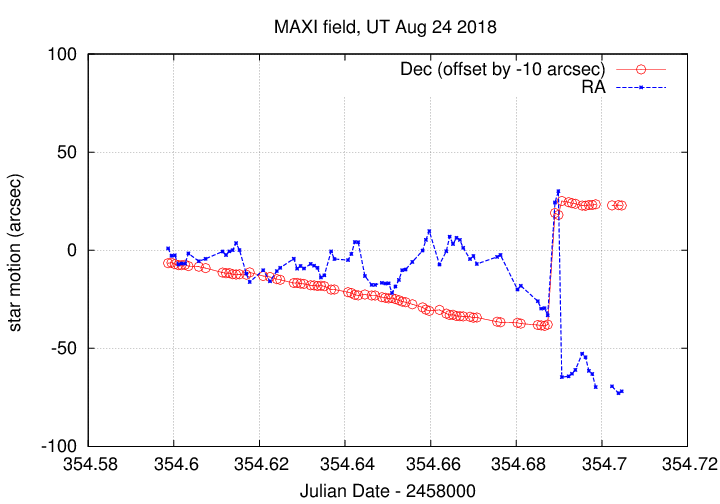
The number of objects detected -- I required 35 objects for an image to be included in the ensemble.
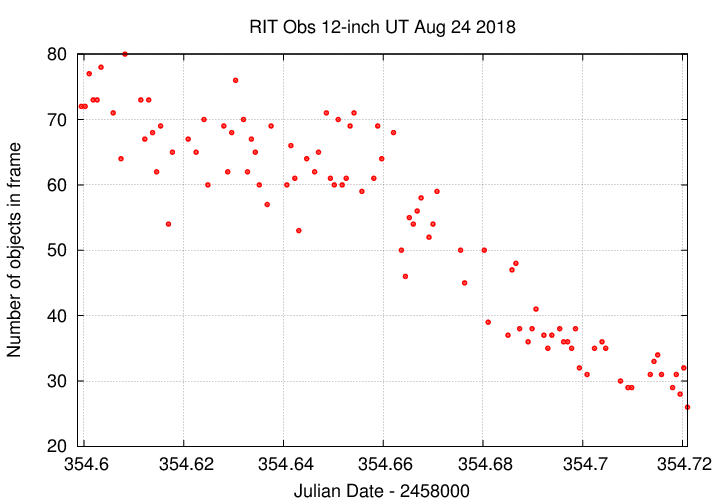
I used an aperture with radius 5.0 pixels. That was barely large enough tonight.

I discarded images which had obvious trailed stellar images, using a threshold of "round > -0.45", a somewhat more extreme value than usual (removing 61 of the 159 raw images).

Using aperture photometry with a radius of 5 pixels (binned 2x2, each pixel is 1.34 arcsec, so a radius of 6.7 arcsec), I measured the instrumental magnitudes of a number of reference stars and the target. Following the procedures outlined by Kent Honeycutt's article on inhomogeneous ensemble photometry, I used all stars available in each image to define a reference frame, and measured each star against this frame.
Sigma-vs-mag plots show that the floor was about 0.009 mag overall, which is not very good. I marked star "A" as variable in the ensemble, as it was saturated. The outlier around instrumental magnitude 2.9 is MAXI J1820+070. Note that star "B" has a larger-than-normal scatter due to its blue color and the second-order extinction at high airmass near the end of the run; I marked it as variable in the ensemble.
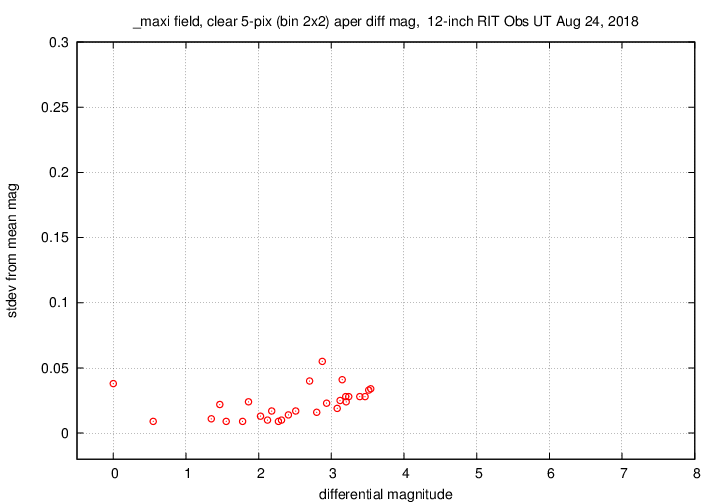
Here are light curves of the variable and the field stars. Note the change in the blue-ish star "B" due to second-order extinction at the end of the run.
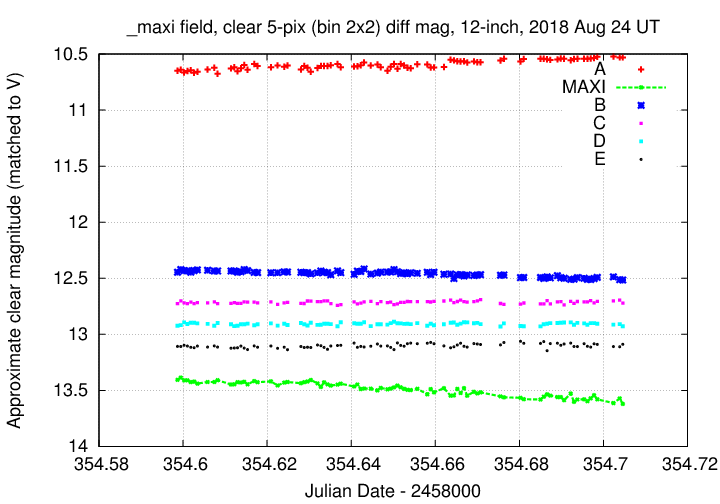
I used the UCAC value for the V-band magnitude of star "B" = UCAC4 486-079513 to shift the ensemble magnitudes to the standard V-band scale -- but remember that these are UNFILTERED measurements.
Here's a closeup on the variable. I'll connect the dots to make its behavior a bit easier to see.
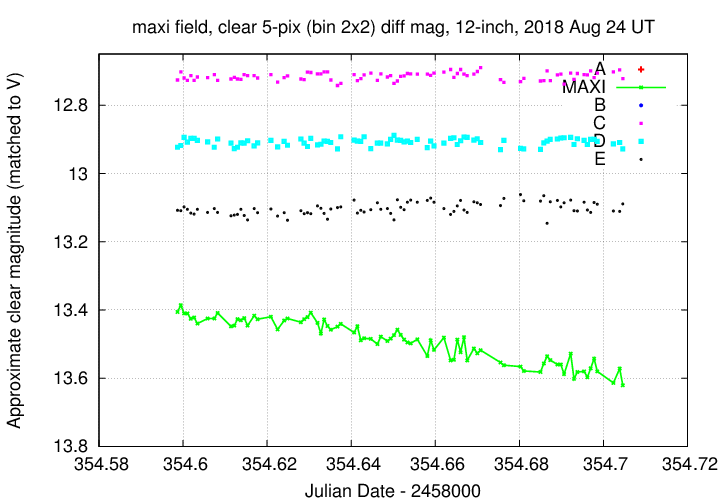
You can download my measurements below. A copy of the header of the file is shown to explain the format.
# Measurements of MAXIJ1820+070 made at RIT Obs, UT 2018 Aug 24, # in mediocre conditions, # by Michael Richmond, # using Meade 12-inch LX200 and ATIK 11000. # Exposures 60 seconds long, no filter. # Tabulated times are midexposure (FITS header time - half exposure length) # and accurate only to +/- 1 second (??). # 'mag' is a differential magnitude based on ensemble photometry # using a circular aperture of radius 5 pix = 6.6 arcseconds. # which has been shifted so UCAC4 486-079513 has mag=12.454 # which is its V-band magnitude according to UCAC4. # # UT_day JD HJD mag uncert Aug24.09867 2458354.59867 2458354.60157 13.406 0.019 Aug24.09946 2458354.59946 2458354.60236 13.386 0.018 Aug24.10024 2458354.60024 2458354.60314 13.410 0.020
Last modified 8/27/2018 by MWR.